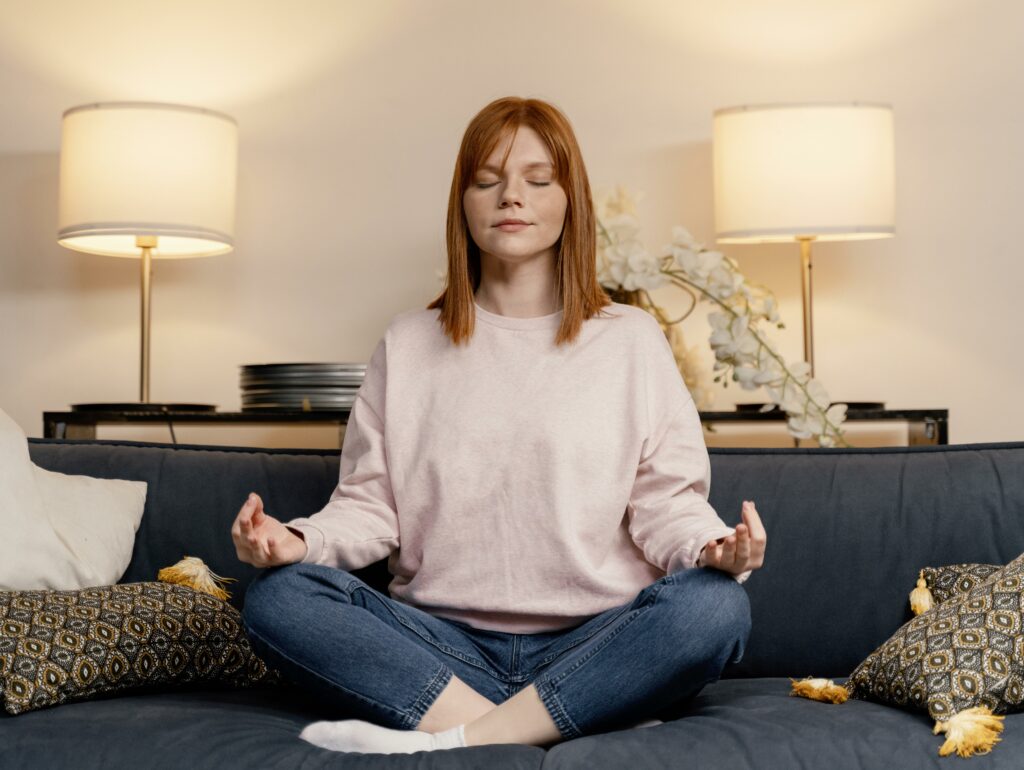In the digital age, where screens glow as seductive fireflies and notifications chime like insistent alarms, true peace can feel like a phantom limb, a phantom we desperately crave but can’t quite grasp. We juggle deadlines, scroll through endless newsfeeds, and chase the elusive “next best thing,” our minds fragmented by a thousand anxieties. In this storm of hyper-connectivity, where stress morphs into a chronic condition and mental well-being feels like a distant dream, mindfulness in mental health emerges as a beacon of hope.

But mindfulness isn’t some mystical chant or trendy app; it’s a deliberate practice, as ancient as the sunrise yet profoundly relevant in the modern world. It’s about cultivating awareness, not of the latest viral video, but of the present moment, the fleeting symphony of sights, sounds, and sensations unfolding around you. It’s about observing your thoughts and feelings without judgment, like watching clouds drift across a clear sky.
Imagine shifting your perspective from being a frantic conductor orchestrating the chaos of your mind to being a curious audience member, present and aware. This shift empowers you to choose how you respond to internal and external stimuli rather than being swept away by their relentless currents.
Why is Mindfulness Relevant to Mental Health?
Our minds are intricate landscapes, and when anxieties and stresses hijack our focus, pulling us into the past or the future, we lose grounding in the present. This constant mental chatter can fuel negative emotions like anxiety, depression, and insomnia.
It acts as a gentle antidote to this turmoil. Anchoring us in the present moment allows us to observe our thoughts and feelings with detachment and acceptance. We recognize them as transient phenomena, like wisps of smoke, rather than defining truths. It empowers us to choose how we respond to them, cultivating emotional resilience and well-being.
Imagine riding the waves of emotions with skill and grace instead of being constantly tossed and turned by their relentless tides. It equips you with the tools to navigate these internal storms with greater ease.
The benefits of mindfulness are as vast and diverse as the night sky:
Reduced Stress and Anxiety: Studies show mindfulness-based interventions can be as effective as medication in managing these conditions, allowing you to shed the heavy cloak of anxiety like a winter coat on a spring day.
Improved Mood and Well-being: By cultivating calmness and presence, it promotes happiness and overall well-being, helping you bloom like a flower under the warmth of the sun.
Enhanced Emotional Regulation: Learning to observe and accept emotions, rather than react impulsively, empowers you to manage challenging emotions like anger or sadness with greater ease, riding the waves of emotion with skill and grace.
Increased Focus and Concentration: By training the mind to stay present, it sharpens attention and reduces distractibility, allowing you to navigate the mental jungle with laser-sharp clarity.
Better Sleep Quality: Mindfulness techniques can quiet the mind before bedtime, promoting deeper and more restful sleep and allowing you to finally surrender to slumber as peaceful as a moonlit forest.
And the beauty? It is accessible to everyone. Unlike medication or therapy, it doesn’t require expensive equipment or a secluded retreat. It can be woven into the fabric of your daily life, even amidst the busiest schedules. A few simple exercises like mindful breathing, body scans, or gentle meditation can be your anchor in the storm, offering pockets of peace amidst the bustling city streets.
So, take a deep breath, release the anxieties of the past and future, and step into the present moment. Your journey towards inner peace begins now.
Cultivating Mindfulness: Your Personalized Toolkit
The beauty of mindfulness lies in its accessibility. Unlike medication or therapy, which require professional guidance, it is a skill anyone can cultivate. It doesn’t require fancy equipment or a secluded mountaintop. It can be woven into the fabric of your daily life, no matter how busy your schedule is.
Here are some simple steps to get you started on your journey:
Start Small: Begin with just a few minutes of mindfulness practice each day gradually increasing the duration as you feel comfortable. Imagine building a tower of peace, brick by brick.
Find Your Anchor: Focus on your breath, bodily sensations, or a mantra to anchor your attention to the present moment. Imagine tethering your mind to a steady point in the rushing river of thoughts.
Embrace Patience: Learning it takes time and practice. Don’t get discouraged if your mind wanders; gently bring your attention back to the present without judgment. Imagine training your mind with the same patience you’d extend to a young puppy.
Be Kind to Yourself: Remember, it is not about achieving perfection; it’s about cultivating awareness and self-compassion. Imagine treating yourself with the same tenderness you’d offer a dear friend.
Seek Support: Your Community of Inner Explorers
Embarking on the journey of mindfulness doesn’t have to be a solitary endeavor. There’s a vibrant community of fellow travelers waiting to welcome you with open arms. Ready to share their experiences and support your growth.
Here are some ways to connect and find encouragement:
Join a Mindfulness Group or Class: Connecting with others practicing it creates a sense of belonging and provides opportunities to learn from each other’s experiences. Imagine sharing your journey with fellow inner explorers, swapping stories, and navigating challenges together.
Find a Meditation Teacher: Seek guidance from a qualified meditation teacher who can tailor practices to your specific needs and offer personalized feedback. Imagine having a wise mentor on your path, someone who can illuminate the way and keep you inspired.
Explore Online Resources: The internet is teeming with valuable resources for mindfulness practitioners. Websites like Mindful.org, Headspace, and Calm offer guided meditations, courses, and articles to support your practice. Imagine having a vast library of tools and techniques at your fingertips, ready to be explored whenever you need them.
Beyond the Blog: Embracing Mindfulness in Daily Life
It isn’t just a practice confined to meditation cushions or yoga mats; it’s a lens through which you can experience your entire life.
Here are some ways to integrate it into your daily routine:
Mindful Movement: Bring awareness to your body during everyday activities, whether it’s brushing your teeth, taking a walk, or washing dishes. Pay attention to bodily sensations, the rhythm of your breath, and the feeling of your feet connecting with the ground. Imagine turning routine tasks into mini-meditations, savoring the simple act of being present in your body.
Mindful Eating: Savor your meals by slowing down and focusing on the experience of eating. Notice the colors, textures, and aromas of your food. Chew thoroughly, appreciating the taste and the act of nourishment. Imagine transforming mealtimes into mindful rituals, honoring your body, and appreciating the abundance around you.
Mindful Communication: Approach conversations with open ears and a curious mind. Listen attentively to the speaker, without judgment or interruption. Be present in the moment, allowing the exchange to unfold naturally. Imagine transforming discussions into opportunities for connection and deep understanding.
These are just a few ways to sprinkle it into the fabric of your daily life. As you become more attuned to the present moment in everyday activities, you’ll discover a sense of peace and presence that permeates every aspect of your being.
Conclusion: Cultivating Your Inner Sanctuary in a World of Noise
It is not a quick fix, a band-aid slapped onto the wounds of a chaotic world. It’s a lifelong journey of self-discovery, a continuous dance with the present moment that unfolds with every breath. It is a commitment to shedding the anxieties of the past and future, and instead, embracing the richness of the here and now. It’s a whispered promise to treat yourself with compassion, navigate your inner landscape with curiosity, and find peace amidst the constant churn of life.
The data speaks volumes:
The study found mindfulness-based therapies to be moderately effective in improving anxiety, with an effect size of 0.63. For individuals with diagnosed anxiety disorders, the effect size was even larger, at 0.97.
A Harvard University study showed that mindfulness meditation increases grey matter density in brain regions associated with learning, memory, and emotional regulation.
A University of California, Santa Barbara study revealed that regular mindfulness practice leads to a 25% increase in positive emotions and a 33% decrease in negative emotions.
These are just glimpses into the vast reservoir of research supporting the transformative power of mindfulness. But numbers can only tell half the story. However the true reward lies in the personal experience, the quiet blossoming of inner peace, the newfound resilience in the face of adversity, and the gentle hum of well-being that pervades your days.
So, take a deep breath in, and as you exhale, let go of any resistance, any lingering doubts. Step into the present moment, not with trepidation, but with curiosity. It is your invitation to cultivate your inner sanctuary, a refuge where anxieties fade and peace blossoms. You hold the key to unlock this haven within, and with each mindful breath, you take another step toward mindfulness in mental health.
Embrace the present. Nurture awareness. And watch your inner world bloom.

